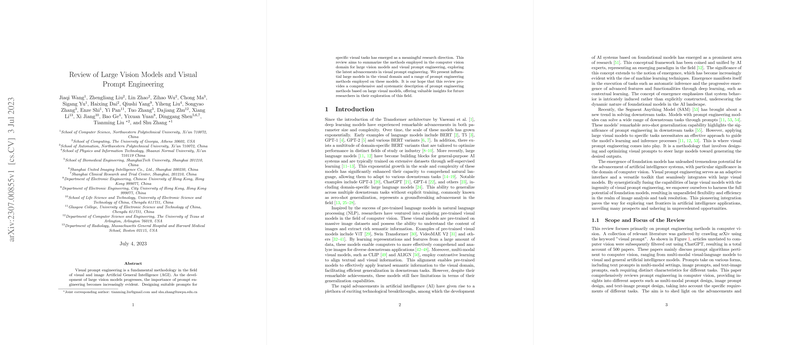Advances and Challenges in Visual Prompt Engineering for Large Vision Models
Introduction to Visual Prompt Engineering
Visual prompt engineering has increasingly become a focal point in the exploration of artificial general intelligence (AGI) within computer vision. This development is especially significant in light of the rapid progression seen in large vision models. The essence of prompt engineering lies in the creation and optimization of visual prompts, which are employed to steer these expansive models towards producing desired outcomes for specific visual tasks. This domain covers a wide array of approaches, including text, image, and text-image prompts, each tailored for varying requirements across different tasks.
Evolution of Large Models and Prompt Engineering
The expansion of large models has been a dynamic and transformative journey, initially spurred by the introduction of the Transformer architecture. Successive advancements have seen models such as BERT, GPT series, and ViT reshape the landscape of both NLP and computer vision. These models, built on extensive datasets through self-supervised learning, demonstrate an impressive ability to grasp and generate natural language and understand image content, showcasing remarkable adaptability across various downstream tasks.
In parallel, the field of prompt engineering has witnessed substantial progress, establishing itself as a crucial methodology in harnessing the potential of large vision models effectively. This includes the development of models like CLIP, which utilize prompts in multi-modal learning scenarios, and SAM, which optimizes for downstream task efficiency through prompt-based approaches.
Key Models and Their Contributions
Several models have been at the forefront of integrating visual prompts into the field of large vision models, including:
- CLIP and ALIGN, which have set benchmarks in aligning textual and visual information through contrastive learning.
- Visual Prompt Tuning (VPT), which introduced a novel approach by modifying the input with task-specific learnable parameters, facilitating efficient fine-tuning.
- SAM, which leverages prompt engineering for a wide array of segmentation tasks, demonstrating the model's strong generalization capabilities in a zero-shot manner.
Prompts in Multi-Modal Learning and Visual Tasks
Prompt engineering transcends mere text manipulation, extending into multi-modal and visually intensive tasks:
- Multi-modal prompts have seen innovations such as CoOP, which introduces trainable continuous vectors as prompts, and DenseCLIP, which adapts CLIP for dense prediction tasks.
- Visual prompts have been instrumental in interactive segmentation and few-shot image segmentation, with methods like VPT and AdaptFormer showcasing efficient fine-tuning strategies.
- The adaptation of foundational models, such as blending SAM with models like CLIP and SD under approaches like Edit Everything and SAM-Track, exemplifies the extensive potential of prompts in enhancing the generalization capabilities of large models across varied tasks.
Future Directions in Prompt Engineering
The exploration of visual prompt engineering indicates a promising trajectory towards realizing the full potential of AGI in computer vision. This includes refining prompt design strategies, improving model adaptability through prompts, and enhancing the interplay between textual and visual prompts for multi-modal tasks.
Conclusion
Visual prompt engineering emerges as a pivotal technique for maximizing the utility of large vision models, bringing us closer to achieving sophisticated computer vision capabilities. The continuous evolution of prompt-based methodologies promises to expand the horizons of what is achievable in AGI, fostering advancements that will likely redefine our interaction with and understanding of visual content in the digital age.
